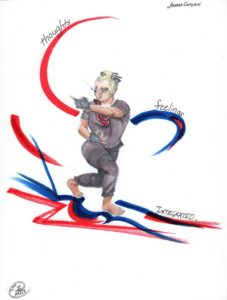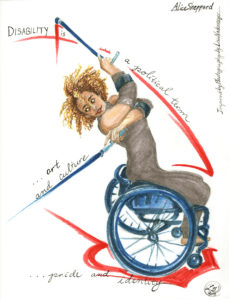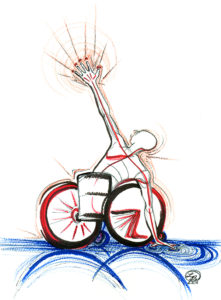Shaking Our Ground
by Silva Laukkanen
After a couple years of research, planning and a whole lot of educational and touching discussions, Emmaly Wiederholt and I are about to publish our second round of interviews from the Discussing Disabilities in Dance book project. Instead of feeling that we are near the end, I feel like we have only just begun to understand the breadth of the field of disability in dance. In every interview, I learn about at least one more artist whose story needs to be recorded, which makes it hard to imagine the end of a project like this. It has been amazing to realize the size of this network and how closely knit it is. Its size and diversity have allowed Emmaly and me to cover many different genres as well as include different disabilities.
Discussing Disabilities in Dance was born back in 2017, when I was invited to join Emmaly Wiederholt and Alice Shepard to brainstorm Alice’s ideas on how to educate and spread the stories of people with disabilities who have been working for some time in the arts. While we did not know at the time what form it would take, I knew immediately that I was on board. After discussing the themes and topics that Alice had voiced, we decided to pair a list of questions with a list of people and compile the resulting interviews into a book. We started interviewing people in 2017 and published our first round of interviews about a year ago. Our team was joined by Liz Brent-Maldonado, a California based artist who has been creating all the vibrant illustrations of our interviewees.
One question that has resonated most with me because of my own tumultuous relationship with the traditional dance field and the hierarchy in it, is the question: Would you like to see disability in dance assimilated into the mainstream? There is huge variation in how people feel about this; the answers to this question can vary from a long discussion of subtleties to a simple yes or no. I love the visions that people have shared with us for the future. Clearly what mainstream means and represents is different from person to person, country to country, and culture to culture.
During these times when a sense of happiness or even motivation is quite the challenge to achieve, this book project keeps me excited and moving. To learn about yet another dancer with a disability working on the other side of the world, or even in the city I live in, is rewarding. What drives me is the constant learning that happens when I listen and work creatively with people whose lives have taken different paths than mine, and whose bodies and minds live their everyday lives differently than I do. It stretches my idea of who can dance and what dance is as an art form. It makes me aware of my preconceived notions of abilities and the way we in which we distribute the positions of authority in the dance field. Contemplating all this makes me want to shake the ground I’m on to rearrange the board.
It fills me with joy to share these important stories that prompt us to contemplate who can dance. It also asks how those of us who are temporarily able bodied to ensure that our work and spaces are accessible and welcoming to all. I hope these interviews make you look around your dance spaces and see who is not there and then ask: Why are they not there and what can I do to make the change?
Silva Laukkanen
Integrated Dance
Art Spark Texas
Image description: Hannah is depicted stepping forward on the diagonal, her legs in a deep bend. Her torso is twisted toward the other diagonal and her arms are held in front of her as if she is embracing something invisible. She is drawn wearing all gray with theatrical eye makeup. Strokes of blue and red swirl around her.
Image description: Alice is drawn facing to the right in her chair, leaning and looking upward and right. Her arms are crossed and crutches extend from either arm. She is portrayed as smiling softly. Quotes from her interview surround her, as well as red streaks of energy and action.
Image description: A figure drawn from the back is sitting in a wheelchair. One hand reaches down to the side of the chair where their hand connects with a blue pool. The other hand reaches up into the air with an open, extended palm. A red line runs from one hand through their back to the other. The figure’s face is lifted upward toward the extended palm.
Image description: Sidiki is depicted playing a djembe drum. The drum is blue and Sidiki is suspended above it wearing white. His hands play the drum and his feet are around his torso. Red lines of energy reverberate around him.





A great idea for a book and yes I continue to discover young artists, all
over the world, exploring PI dance. It is refreshing to see youth and their curiosity
take inclusion to new places.